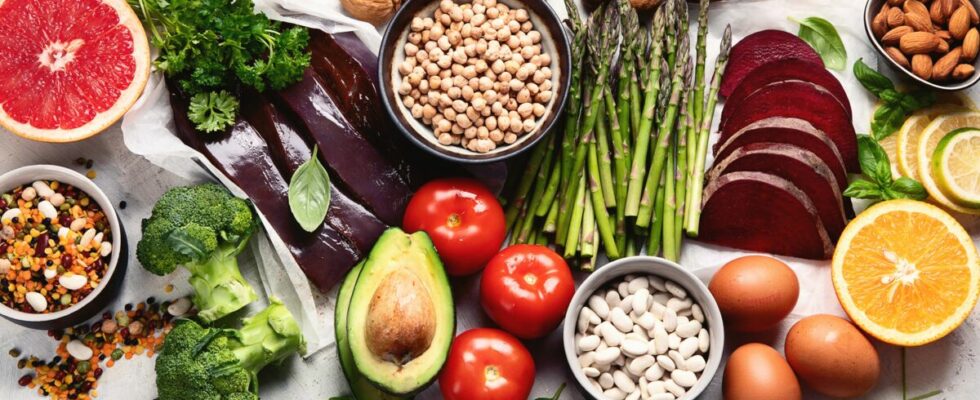Folate is mainly present in green leafy vegetables and dried nuts. The recommended nutritional intakes of vitamin B9 change with your age. Furthermore, the needs are greater in the event of pregnancy or breastfeeding. Folic acid deficiencies can have a serious impact on your health and that of the baby. They can have various origins. Find out what the recommended intakes of folic acid are, what the risks of a deficiency are, and what foods are rich in vitamin B9.
The role of folic acid in the body
Folic acid, also called folate or vitamin B9, refers to a water-soluble vitamin, that is to say soluble in water, which is involved in cell renewal as well as growth. The functions of this vitamin are:
- Prevention of congenital malformations in the embryo, particularly in the development of its nervous system.
- Cell renewal: vitamin B9 is involved in the formation of red blood cells, responsible for transporting oxygen to organs and tissues. And also in the formation of white blood cells, which participate in the body’s immune defense.
- Prevention of cardiovascular diseases: in collaboration with vitamin B12, vitamin B9 helps reduce the level of homocysteine in the blood. However, this amino acid, at a high level, represents a risk factor for cardiovascular disease (myocardial infarction, stroke).
- The proper functioning of the nervous system.
Recommended intakes of vitamin B9
The recommended intakes of vitamin B9 change throughout life, and also vary depending on the woman’s situation. In fact, if you are pregnant or breastfeeding, your vitamin B9 needs are higher. According to the National Agency for Food, Environmental and Occupational Health Safety (ANSES)a satisfactory intake expressed in micrograms per 100 g is:
- For an infant: 65 µg/100 g, if he is less than 6 months old, and 80 µg/100 g if he is more than 6 months old.
- For a child: 120 µg/100 g if the child is between 1 and 3 years old, 140 µg/100 g between 4 and 6 years old, and 200 µg/100 g if the child is 7 to 10 years old.
- For an adolescent: 270 µg/100 g if they are between 11 and 14 years old, and 330 µg/100 g if they are between 15 and 17 years old.
- For an adult man or adult woman: 330 mcg/100 g.
- For a pregnant woman: 600 mcg/100 g.
- For a breastfeeding woman: 500 mcg/100 g.
The risks of folate deficiency
Folate deficiencies can have various causes, and, depending on their importance, can have a greater or lesser impact on your health and that of the baby you are carrying or breastfeeding. Among the causes of folate deficiency highlighted by the MSD Manual are: a diet low in fruits and green leafy vegetables, unmet higher needs during pregnancy or breastfeeding, side effects of certain medications (against diabetes, high blood pressure, etc.) or even malabsorption of vitamin B9 (following diarrhea, stress, intestinal disorders, etc.). Chronic alcoholism is also a possible cause of these folate deficiencies.
Folic acid deficiencies result in various clinical signs. We thus observe anemia with its suite of symptoms: pallor, dyspnea on exertion, fatigue, irritability, dizziness, or even headaches. But also, in case of significant vitamin B9 deficiency, a red and painful tongue, diarrhea, weight loss and depression, informs the MSD Manual. Finally, if you are pregnant, an insufficient intake of folic acid can have serious repercussions on the development of the embryo: risk of premature birth, stunted growth of the baby, as well as a high risk of birth defects. neural tube (spina bifida, i.e. a failure of closure of the spinal column containing the spinal cord).
Foods richest in folic acid
Certain foods are particularly rich in folic acid. Thus, ANSES recommends the consumption of green leafy vegetables (spinach, salads, Brussels sprouts, chard, endive, broccoli, etc.) and legumes (chickpeas, lentils, dried beans). Certain fruits are also good sources of folic acid. There are fresh fruits such as kiwis, strawberries, melon, oranges, lemons, tangerines and pomelos. But also dried nuts such as walnuts, hazelnuts, pistachios, almonds or chestnuts. Finally, consuming liver (lamb, veal, heifer), brewer’s yeast or also hard-boiled eggs can help you avoid folate deficiencies.
Sources
- Folates, don’t wait until you’re pregnant to invite them to the table!Ministry of Health and Prevention
- Folate deficienciesThe MSD Manual, November 2022
- Everything you need to know about vitamin B9Anses, October 27, 2022
- Nutritional references for vitamins and mineralsAnses, April 23, 2021
Read also :
⋙ Vitamins A, B, C, D: which vitamins should I choose based on my needs?
⋙ Vitamin B12 deficiency: symptoms that should alert you and how to stock up
⋙ Vitamin D deficiency during winter: what are the signs and what to do? Answers from a nutritionist
